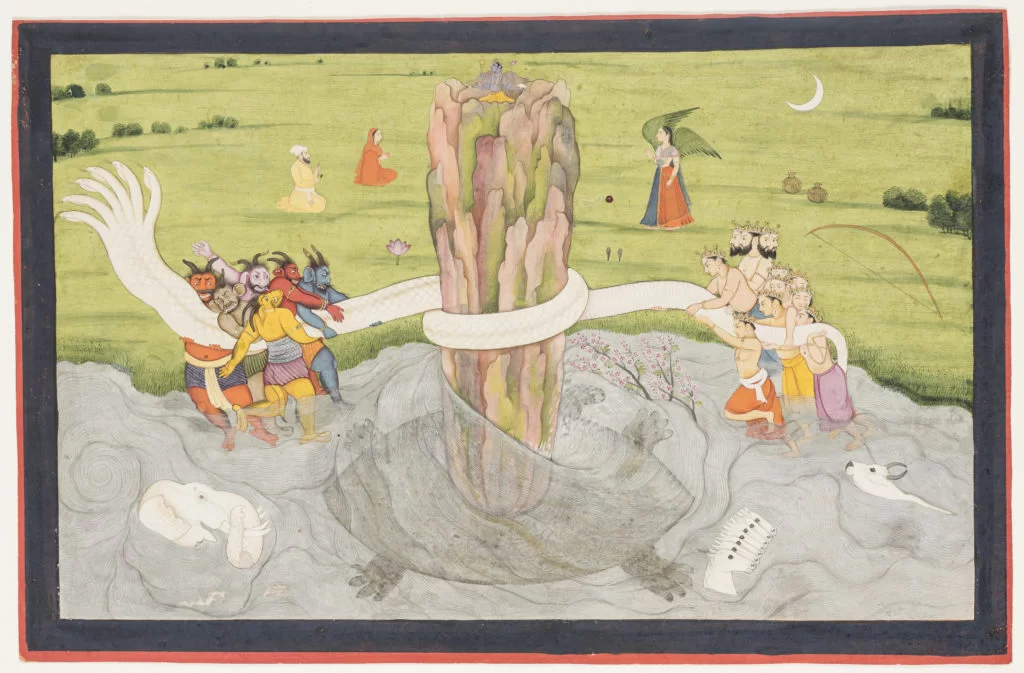THE CHURNING OF THE OCEAN OF MILK: WHY IS AYURVEDA SO IMPORTANT?
Why is Ayurveda so important in the yoga tradition?
Ayurveda is quite often considered the sister science of yoga.
'Ayur' translates to life, and 'veda' translates to knowledge. So, it's the knowledge of life, sometimes called 'the science of life'.
This story has particular significance as far as ayurveda is concerned, through the deep symbology of the tales that unfold in this universe.
As with all Hindu mythology, there are many versions of this story and even more interpretations of the meaning behind it.
Today, I share with you this story as taught to me by my teachers Rose Baudin and Dr. Robert Svoboda.
The Churning of the Ocean of Milk
Our story begins with Indra, the king of the demigods and the lord of rain and thunder. Indra was riding his elephant one day when he came across a great sage named Durvasa. Durvasa was renowned for being easily irritated and for that reason, most feared and respected him. Durvasa offered Indra a special garland of flowers. Indra accepted the garland and, with intention to display it for all to see, placed it on the trunk of his elephant. The garland of beautiful, fragrant flowers attracted a swarm of bees causing the elephant to swiftly throw the garland to the ground.
This offended Durvasa greatly as the garland was sacred, and he cursed Indra as well as all the other devas (demigods) and condemned them to lose their great strength and good fortune.
After this, a reign of terror coursed through the heavens. With the devas powerless, the asuras (demons) were in charge; they gained control of the universe and Indra lost his kingdom.
Having lost all their power, the devas sought help from the wise Vishnu, the one who keeps balance, who suggested they join forces with the asuras to churn the ocean of milk and bring forth the Amrita (the elixir of immortality).
The asuras agreed to partner with the devas in exchange for half of the bounty they were sure to receive. The devas agreed, however Vishnu assured them of his plan to outsmart the asuras and keep the Amrita from them, as no good could come from the asuras gaining immortality.
And so, they gather their resources in order to churn the great primordial ocean.
The enlist the help of Vasuki (king of the serpents) as a churning rope and wrap him around Mount Mandara as the churning rod. Vishnu, who has many avatars, incarnates himself as Kurma, the great tortoise and rests the mountain on his shell in the ocean, so as not to let it sink.
The asuras hold the head of the great naga (snake) and the devas hold the tail.
And they begin on this colossal game of tug-of-war, causing the mountain to rotate, thus churning the great primordial ocean.
The devas pull, then the asuras, the devas, then the asuras. This push-pull goes on for thousands of years before anything happens.
The first thing to bubble to the surface of the ocean is the Halahala poison which threatens to kill everyone.
Luckily Shiva, being pure consciousness, drinks the Halahala poison and with the help of Parvati, holds the poison in his throat, so as not to endanger him or anyone else.
The churning continues.
Following the poison was many wonderful gifts such as Lakshmi, the goddess of good fortune, as well as Chandra, the moon worn on Shiva's head, Airavata and several other elephants, Kaustubha, the most valuable jewel in the world, worn by Vishnu, Uchhaishravas, the divine 7-headed horse, and many other gifts and boons.
Finally, Dhanvantari - the god of ayurveda comes to the surface, holding in his hands the Amrita.
As Amrita was finally revealed, the devas and asuras immediately reverted to their rivalry and tried to obtain the elixir for themselves. Vishnu, having a plan all along, then incarnated himself as a beautiful woman named Mohini, the enchantress who is said to be the most beautiful creature in existence, irresistible to everyone who encounters her. She distracts the asuras while the devas hurriedly swallowed the Amrita and gain the ultimate prize of immortality.
So, what is the symbology of this story?
Firstly, we look to Indra, who with no ill intention, enrages Durvasa who robs not only him, but all of the devas, of their powers. This is symbolic of the unexpected things that life can throw at us, leaving us unstable and seemingly robbed of our power. It's often in these hard times, we turn to something bigger than ourselves. In this case, it was the ocean of milk and the Amrita.
We learn also, that if we want to receive the boons that this great primordial ocean has to offer, we must enlist the help of the good and the bad within us.
Neither the devas or the asuras were capable of churning the ocean on their own.
This shows us the significance of not only acknowledging the darkness inside us, but utilising it, learning from it and understanding it to achieve what we need. In this case, immortality.
This whole process of churning the great ocean is symbolic of what happens when we begin on our yoga practice. We begin to stir and move prana. This has a ripple on effect, which more often than not, is a very slow and arduous process. You may be practicing for years before you experience the great gifts of the practice. Ask anyone who's tried meditation.
As is said in the story, nothing happened for several thousands of years.
Following this, when something finally did emerge from the ocean, it was not the Amrita that we were hoping for, but rather, the Halahala poison.
The symbology here is that often, when we stir things up inside us, when we begin to look within, we don't always like what we uncover. Especially if we've been avoiding looking within for a long time.
Shiva represents pure consciousness and that being so, he was able to hold the poison in his throat without being affected by it.
Here, we learn that even the darkest things inside us, held in pure consciousness, can be harmless. As long as we acknowledge them, hold them in our awareness, and continue to choose otherwise, we are okay.
Finally, we see that Dhanvantari, the god of Ayurveda, is the one who emerges with the Amrita.
This is a clear indication of the importance of Ayurveda on this path. In order to receive the gifts of the practice, we must be balance.
This is why ayurveda is important.
Over the next months, I'll be sharing more posts on Ayurveda, the doshas and how to pacify the energies we have too much of in our bodies.
If you're interested in learning more about Ayurveda, have a read of some of my other blog posts.
Learn the vert calming and grounding ayurvedic practice of self oil massage: Abhyanga.
I hope you discerned some piece of wisdom from this story. I know I get more from it each time I read, tell or hear it.
Hindu mythology is cool like that.

